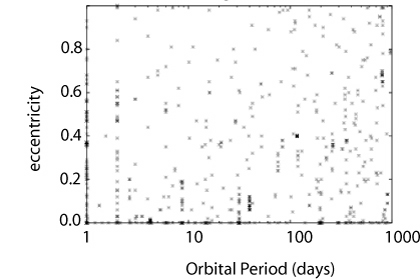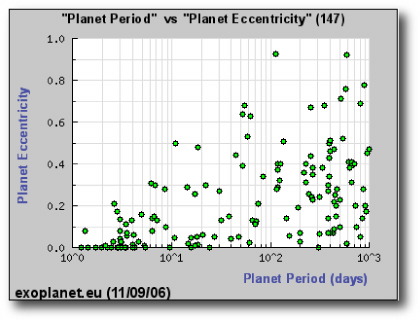
Image Source.
It’s good to see that users are still streaming into the systemic collaboration, and activity on the back-end is staying strong. The catalog of submitted radial velocity fits is now approaching 1,000 entries, and nearly every data-set has at least one fit. We need more users, though. Both Stefano and Eugenio have been working very hard behind the scenes to engineer improved usability for the site. There are a lot of items that are still on our plate, but progress is definitely being made.
We can now internally query the database of submitted fits to statistically characterize the planetary models that are being submitted. Once this functionality is fully tested, it’ll be made available to all users on the site. For example, here’s a plot of eccentricity vs. period for all of the fits submitted with 0.8 < chi-square < 2.0:

It’s interesting to compare this with the plot that one can produce at exoplanet.eu based on the static catalog of published planets:

One immediately notices that the diagram produced from the back-end data is populated in the upper left hand corner, whereas this region in the published catalog is completely cleared out. Note that planets in this region are known from theoretical arguments to be tidally circularized… (tune in soon for more on that issue).
One final note. The downloadable console is now much lighter. The large filesize of the previous version was due to the very extensive synthetic data sets for alpha Centauri. If you want the alpha Centauri velocities, the fully loaded console that contains the alpha Centauri data is here. Within a day or so, we’ll be updating the downloads page to reflect this change and to give more guidance for International Windows users.

On the final note:
The second .zip file contains only the synthetic Alpha Cen velocities plus a modified defaultsystems.txt file. There will be more on this when we update the downloads page.
Eugenio